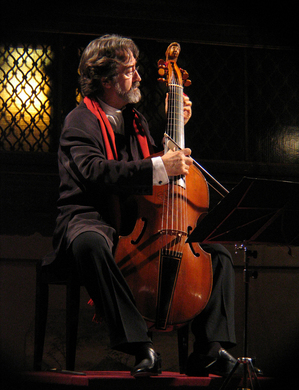'Route to the New World' concert will explore musical intersection of Spain, Mexico

Jordi Savall brings his early Spanish music ensembles to Ann Arbor.
When Spain came to Mexico in the 16th century, its culture traveled by sea from the Old World to the New as it became a colonial power.
Today, the ocean still needs to be traversed, but airplanes do the trick. And sometimes a mere recording — serving as a modern-day report of a realm of gold, if you will — can be the motivation for the journey.
That’s what happened for the Spanish early music master Jordi Savall, whose fall U.S. tour brings him to Ann Arbor Thursday with his two Spanish ensembles — the Capella Reial de Catalunya and Hesperion XXI — and the Mexican chamber group Tembembe Ensamble Continuo, which explores the intersections between Hispanic baroque music and traditional music from Mexico and Latin America.
Savall, whose instrument is the viola da gamba, an early cello, came across Temembe Ensamble when he was working on a soundtrack for a film by Mexican director Francisco Athie, “El Baile de San Juan.”
“I was preparing some music for this project,” Savall said recently by phone from Spain, “and I received some examples of local musicians’ work. One of them was Ensamble Tembembe.” Savall and his groups subsequently played with Ensamble Tembembe in the Cervantino Festival in Guanajuato, Mexico, in 2008. “It was a great success,” he said, “and I invited them to Barcelona in 2009 to do a recording.”
That recording, the newly released “El Nuevo Mundo — Folias Criollas” (the folias are dances that blend Spanish and New World forms), and an earlier Savall recording, “Villancicos Y Danzas Criollas: De La Iberia Antigua Al Nuevo Mundo (1550-1750),” form the basis for Thursday’s concert, Savall said.
The CDs, like the concert, focus on the cross-fertilization that came with the Spanish conquest of Mexico, and the music takes us up to the present, with a look at Mexican traditional styles like the “son huasteco” and the “son jarocho,” still practiced today.
“The first musicians come with sailors, with the people from the boats,” Savall said, discussing the often-improvisatory music that came with the conquistadores in the 16th century. “They sing and play guitars — those are the easiest to bring. Professionals would bring the court instruments, the harp and the viols.”
Africans, exploited as slaves, and the indigenous Indians contributed their voices, musical forms and instruments to the musical mix. “This is very evident,” Savall said “in many of the pieces, like the chaconas, that we consider Spanish. They were influenced by the New World.”
PREVIEW
"The Route to the New World: From Spain to Mexico"
- Who: La Capella Reial de Catalunya and Hesperion XXI, Jordi Savall, music director; and Tembembe Ensamble Continuo.
- What: Concert exploring musical histories of Mexico and Spain, presented by the University Musical Society.
- Where: St. Francis of Assisi Catholic Church, 2250 East Stadium Boulevard.
- When: 8 p.m. Thursday.
- How much: $35 and $45, available from the Michigan League Ticket Office, by phone at 734-764-2538; or online at the UMS website.
The recording project and the concerts, Savall has written, are an attempt “to contribute to the rediscovery and dissemination of music which has been kept alive for centuries, often in regions remote from the major towns and cities.”
It is also, he adds, “a sincere homage to all the men and women, most of them anonymous, whose sensitivity and musical talent, as well as their great capacity for transmission, have contributed to that music’s survival to the present day. The “Sones” and Creole FolÃas of this New World reveal a fascinating dialogue between the music that ‘survived’ in the Llanero and Huasteco oral traditions and in the anonymous mestizo folk repertoires, influenced by the Nahuatl, Quechua and African cultures, and the historical music from the Renaissance and Baroque periods preserved both in manuscript and printed form in Old and New Spain.”
In the dances and songs, instruments of Old and New World origin blend, as do lyrics. Flutes came from the Indian natives, Savall said. For percussion, there is the quijada, the jawbone of a horse or donkey (the teeth rattle when it is struck) and the tambourine-like Spanish and Latin American frame drum called the pandero. And from that Spanish import, the guitar, comes a legion of descendents in all sizes, each, Savall said, with “a very specific sound and specific repertory.”
For the early repertoire that the concert includes, it might have been nice to have a sackbut, too, a trombone-like instrument of the Renaissance and Baroque. But present-day realities intrude.
“The concert will not have this,” Savall said. “The question is, it’s too expensive when we come with so many people.”
Susan Isaacs Nisbett is a free-lance writer who covers classical music and dance for AnnArbor.com.


Comments
Scylding
Sun, Sep 26, 2010 : 7:55 p.m.
@Bedrog Yet another item we share in common. I have a couple of Jordi's recordings and love them. Early European terpsichore. I asked A2.com to give me your contact info. I'll be in touch if they do.
bedrog
Sun, Sep 26, 2010 : 6:31 a.m.
jordi savall and company/family are musical pearls beyond price. it will be a great show, as ever. A point of correction though: the viola da gamba, a fretted instrument ( unlike the cello) and with at least 6 strings ( instead of 4) is more akin to the lute,or the guitar shaped spanish vihuela,whose repertoire and left hand fingering it shared. but it is of course bowed like more modern violins and cellos, although it can also be plucked, as savall will no doubt do in places.